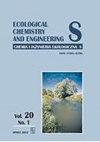通过可持续海藻生物复合材料开发生态友好型生物塑料材料
IF 2.5
4区 环境科学与生态学
Q3 ENVIRONMENTAL SCIENCES
Ecological Chemistry and Engineering S-Chemia I Inzynieria Ekologiczna S
Pub Date : 2023-09-01
DOI:10.2478/eces-2023-0036
引用次数: 0
摘要
摘要本研究的重点是利用海藻基生物复合材料开发一种环境友好型生物塑料材料。对海藻生物质(Gracilaria edulis)进行加工,并与淀粉、甘油、冰醋酸和壳聚糖结合,制备柔韧、均匀的生物聚合物薄膜。这些薄膜表现出与商业塑料相当的物理性能,并保留了其固有的颜色。光谱分析显示强烈的UV-Vis峰点与海藻成分一致。力学试验表明,该材料具有良好的强度和柔韧性,与淀粉基生物塑料相似,抗拉强度为3.383 MPa,低延伸强度约为31.90%。材料迁移试验表明,偏爱水,表明适合低水分的食物。生物塑料薄膜显示出显著的生物降解性和可堆肥性,展示了其作为食品包装可持续替代品的潜力。这一创新贡献推动了生态友好型生物塑料材料的发展,解决了塑料污染问题,促进了生物复合材料的使用。本文章由计算机程序翻译,如有差异,请以英文原文为准。
Eco-Friendly Bioplastic Material Development Via Sustainable Seaweed Biocomposite
Abstract The study focused on the development of an environmentally friendly bioplastic material using sustainable seaweed-based biocomposites. Algal biomass ( Gracilaria edulis ) was processed and combined with starch, glycerol, glacial acetic acid, and chitosan to create flexible, homogenous biopolymer films. These films exhibited comparable physical properties to commercial plastics and retained their inherent colour post-processing. Spectroscopic analysis revealed intense UV-Vis peak points aligned with seaweed composition. Mechanical testing demonstrated adequate strength and flexibility, similar to starch-based bioplastics, with a tensile strength of 3.383 MPa and lower elongation strength of about 31.90 %. Material migration tests indicated a preference for water, suggesting suitability for low-moisture foods. The bioplastic film displayed notable biodegradability and compostability, showcasing its potential as a sustainable alternative for food packaging. This innovative contribution advances eco-friendly bioplastic material, addressing plastic pollution and promoting biocomposite use.
求助全文
通过发布文献求助,成功后即可免费获取论文全文。
去求助
来源期刊
CiteScore
2.80
自引率
36.80%
发文量
32
审稿时长
>12 weeks
期刊介绍:
The quarterly Ecological Chemistry and Engineering S is a multidisciplinary journal devoted to the publishing of original scientific papers, review articles, professional papers, case reports and varia (professional information, book reviews, etc.).
It is pertinent to describe methods determining quality of air, water, soils and food.
Many papers published are on monitoring and biomonitoring of an environment and on transfer of pollutants (eg heavy metals or radionuclides) from soil to plants. Some Authors consider impact of environment pollution on food and human health.
Some papers describe models of pollutant spreading in air or within soil. Others are devoted to various technologies to prevent or minimize industrial pollution, as well as to remediation techniques.
Papers on renewable energy sources are also very welcome.

 求助内容:
求助内容: 应助结果提醒方式:
应助结果提醒方式:


